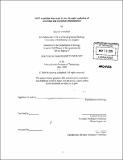SirT1 regulates bone mass in vivo through regulation of osteoblast and osteoclast differentiation
Author(s)
Zainabadi, Kayvan
DownloadFull printable version (26.63Mb)
Other Contributors
Massachusetts Institute of Technology. Dept. of Biology.
Advisor
Leonard Guarente.
Terms of use
Metadata
Show full item recordAbstract
As mammals age, osteoblast numbers decrease while osteoclast numbers increase, resulting in age-related or post-menopausal osteoporosis. SirT1, the mammalian orthologue of yeast Sir2, has been shown to be a negative regulator of PPAR[gamma] and NF[kappa]B, two transcription factors important for the differentiation of osteoblasts and osteoclasts, respectively. Here, we show that SirT1 is an important regulator of bone mass in vivo: SirT1 whole-body knockout mice display significant bone deficiencies that are associated with decreased osteoblast and increased osteoclast numbers. Further, osteoblast (ObKO) and osteoclast (OcKO) specific SirT1 knockout mice also show an osteoporotic phenotype that is associated with decreased osteoblasts in the ObKOs and increased osteoclasts in the OcKOs. In osteoblasts, we find that instead of targeting PPAR[gamma], SirT1 interacts with and increases the transactivation potential of Runx2. In osteoclasts, SirT1 inhibits differentiation largely through repression of the p65/RelA subunit of NF[kappa]B. Finally, we show that calorie restriction (CR) results in increased bone mass that is associated with higher osteoblast and lower osteoclast numbers - the inverse phenotype of SirT1 knockout mice. We find CR induces expression and activity of SirT1 in bone, and that SirT1 knockout mice fail to show any increases in bone mass in response to CR. Our results therefore provide the first evidence that SirT1 is an important regulator of bone mass in vivo, possibly providing a link between bone remodeling, metabolism and osteoporosis.
Description
Thesis (Ph. D.)--Massachusetts Institute of Technology, Dept. of Biology, 2009. Includes bibliographical references.
Date issued
2009Department
Massachusetts Institute of Technology. Department of BiologyPublisher
Massachusetts Institute of Technology
Keywords
Biology.